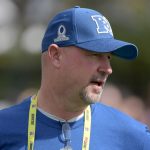Baseball’s best athletes have usually been found at the shortstop position, whether they stick there or get moved to a different spot in the field. But, even for a position in baseball that has had names like Cal Ripken Jr., Derek Jeter, Ozzie Smith, Ernie Banks, and many more claim that spot on the infield, the current Era of shortstops is unprecedented.
With players like the Dodgers Corey Seager, the Indians Francisco Lindor, and Carlos Correa of the Astros headlining the position, we’re not only talking about talented, young shortstops, but these players could be included in a list of some of the league’s elite players altogether.
And with the league’s next generation of franchise faces predominantly playing the shortstop position it’s easy to overlook a player like Addison Russell, who not only tied 2016 gold glove winning shortstop Brandon Crawford with 18 defensive runs saved, but he also hit 21 home runs and drove in 95 RBI last season.
The 23-year old Russell offers elite-level of skill at the plate and in the field, and while many of the other up-and-comers at shortstop might be better at one aspect of the game than the Cubs infielder, Russell’s ability to hit and play gold glove-caliber defense gives him the highest ceiling out of any of the game’s best shortstops.
Russell has always found ways to make improvements at every level, starting during his time in Oakland’s farm system. Many scouts expected Russell would have to make a position change in order to stick in the MLB. But, instead of moving to second base, Russell worked harder on improving his lateral movement and even shed close to 20 lbs. to stay at shortstop. Current FanRag Sports MLB scout Bernie Pleskoff’s scouting report of Russell when he was still apart of the Athletics system, predicted the current Cubs shortstop to present an elite power bat along, while also staying at shortstop
Since coming into the majors, the biggest adjustment for Addison Russell has been strikeouts. In 2015, Russell struck out 28.5% of the time but was able to show a slight improvement in 2016, dropping his total down to 22.9%, while also increasing his walk totals.
Amongst all these changes, Addison Russell made a major adjustment at the plate that allowed him to start elevating more pitches as the season went on. MLB Network’s Mike Petrillo outlines what I am talking about in the tweet below.
Here’s Addison Russell’s monthly launch angle. You might say there’s a trend happening. pic.twitter.com/8C8v9lIMia
— Mike Petriello (@mike_petriello) August 29, 2016
Scout had already praised for his tantalizing bat speed but with him improving his launch angle, it translated to more balls driven out of the park. His home run/fly ball rate supports this as well, increasing nearly four points to 14.2% in 2016, meaning when Russell was able to elevate a pitch it more than likely a home run.
Teams in the playoffs became more aware of this and tried to make the young shortstop elevate pitches low and away, making it harder for Russell to get the bat of the barrel on the ball, however, he eventually made the adjustment and started mashing balls like Cubs fans were accustomed too.
Russell actually improved his barrel contact as well in 2016, going from 6% to 10.4%, showing Russell was taking full advantage of better hitters counts he was creating for himself due to a more patient approach at the plate. But, you can break down as many stats as you want when it comes to Addison Russell, what it all boils down to is this: Shortstops are not supposed to hit as hard as he does, and it makes him standout.
Russell is a smart, hardworking player that is constantly covered up by his teammates like reigning NL MVP Kris Bryant and superstar first baseman Anthony Rizzo, but I believe that all changes in 2017.
It is incredibly rare to find a shortstop who possesses the power of a corner outfielder but also could also be named the league’s best defensive player, it just doesn’t happen. But with players like Corey Seager or Francisco Lindor stepping into the role of superstars, it’s becoming far more common.
Of course, Russell still has his flaws at the plate, as he still swings and misses on a great deal of breaking pitches. His strikeout rate, while dropping almost six percentage points, still needs to improve. And even though he produced excellent power numbers, his incredible 2015 .324 BABIP fell to a less-than-average .277 while slashing .238/.321/.417, in 2016.
But, what makes Russell so intriguing is, unlike the majority of the league’s top shortstops, power is a potential they can see in some of the players, while Russell has already proven he has it. He just has to become a more discipline player at the plate, something he can improve at as he continues to get more at bats, but having an average exit velocity in the high 80’s isn’t something you can teach or learn.
If Russell can be more consistently patient at the plate, while continuing to pulverize major league pitching, it will be hard not to consider the Cubs shortstop the top overall player at his position.












